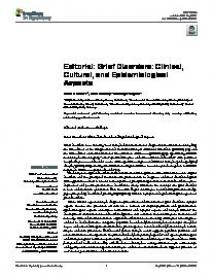Editorial : Grief Disorders : Clinical, Cultural, and Epidemiological Aspects
Grief disorders have recently been included in international diagnostic classifications, including the 5th edition of the Diagnostic and Statistical Manual of Mental Disorders [DSM-5; (1)] and the 11th edition of the International Classification of Diseases [ICD-11; (2)]. Specifically, DSM-5 now includes the category “other specified trauma- and stressor-related disorder,” with persistent complex bereavement disorder as one of the specific examples, and ICD-11 includes prolonged grief disorder (PGD). Importantly, the DSM-5 steering committee has announced an update to DSM-5 to include PGD as a separate disorder (3).
The inclusion of grief disorders marks international recognition of the clinical relevance of grief disorders and has prompted mental health professionals to diagnose and treat disordered grief. Although bereavement is known to be capable of precipitating common mental disorders such as depression and posttraumatic stress disorder, to many clinicians, the concept of a grief disorder is new and therefore unfamiliar. This Research Topic contributes toward filling the knowledge gap surrounding disordered grief by highlighting clinical, cultural, and epidemiological aspects of grief disorders.
While clinical aspects include diagnosis, prevention, and treatment of grief disorders, cultural aspects involve the provision of care in a context of multiculturalism and globalization. Epidemiological aspects encompass both clinical and cultural aspects and include risk for the development or maintenance of disordered grief as well as factors that contribute to resilience and recovery. Risk and resilience factors of grief disorders relate to meaning attribution following loss and can be divided into five categories (4). First, loss-related factors include non-natural or sudden causes of death and the person’s immediate grief response. Second, cultural factors include beliefs, rituals, and care provision. Third, social factors include social support, juridical, political, and economic factors, among others. Fourth, individual factors include gender and age, neurobiological and immunological correlates, personality and attachment, and history of trauma and loss. Fifth, factors related to the relationship with the deceased include a variety of factors, such as the nature and quality of the relationship, farewell rituals, and involvement in the death. Figure 1 presents an overview of potential risk and resilience factors.
In: Frontiers in Psychiatry ; ISSN: 1664-0640 | 12 | 681523
https://doi.org/10.3389/fpsyt.2021.681523
Open Access


